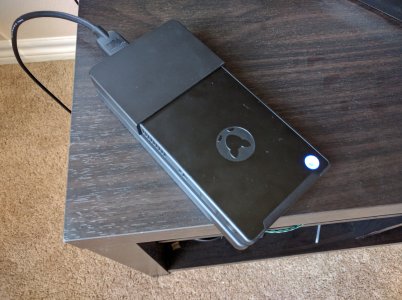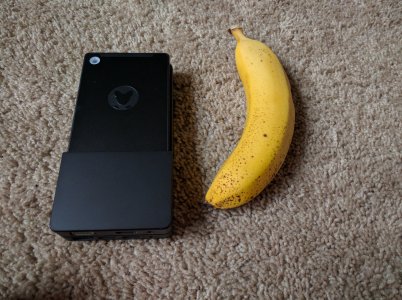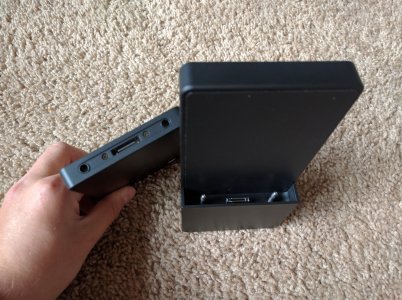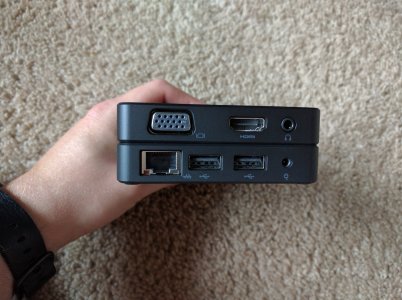
One cool thing about being into technology is watching things progress over time. For example, the iPhone 6 has 120 million times as much computing power as the original Apollo rocket. This has led to computers going from the size of entire rooms to fitting in the palm of our hands (and on our wrists).
This brings us to the Infocus Kangaroo Mobile Desktop Pro. The actual guts of the Kangaroo are housed in a smartphone sized package, and inside you have an Intel Atom processor, 2 gigabytes of RAM, 32 gigabytes (I had about 22 or so available after my initial setup) of EMMC storage, and it?s running the desktop version of Windows 10. It?s impressive that a true desktop fits inside such a small package. The main unit also features a Micro-SD card slot, a Micro-USB port and a fingerprint reader. The Kangaroo has approximately 4 hours of battery life when not docked, and can be recharged through the Micro-USB port. Unfortunately, the Micro-USB did not work with any of my on-the-go adapters, which would have converted that to a full size USB port.

The other piece of the Kangaroo is the docks. The standard dock includes an HDMI port, a USB 3.0 port, a USB 2.0 port, and the power port. The Pro dock (which I have here) adds an additional USB 2.0 port, a VGA port, an Ethernet port, and a 3.5 mm headphone jack. Both the standard and Pro docks include a slot for a 2.5-inch hard drive, giving you even more expansion options.
Setting the Kangaroo up was no different than any other Windows 10 PC, with the addition of registering your fingerprint to use that to unlock the system. Like all Windows Hello login methods, the fingerprint is encrypted and stored on the local device. If you opt in to use Windows Hello, Microsoft will record which method (fingerprint, Iris recognition, etc) you used to better tune their development, but no identifiable information is uploaded to their servers. You can learn more about the Windows Hello system here.

Once you get logged in for the first time on a new PC, you?ll need to check for system updates. Additionally, you?ll need to check for any app updates inside the Windows 10 Store. This is where you?ll quickly run into the Kangaroo?s limitations: the PC crashed three times while installing all the available system and driver updates, and crashed twice trying to install all the app updates.
Fortunately, there isn?t any bloatware like McAfee or trial programs: just clean Windows 10. The performance is decent if you adjust your expectations and workflow. I installed the Word and Powerpoint app from the store, and they worked quite well as long as I just did one task at a time. I tried to create a simple Powerpoint presentation for school, and it worked well enough, though it would have been much faster on any laptop.

And therein lies my problem with the Kangaroo: I don?t see a viable use case for it. I purchased it to be used as a simple media server, but even running Younity gave the machine problems. Infocus?s marketing touts it as productivity on the go: you (or more likely, your employer) would have a set of docks scattered around, and each employee just plugs in their individual Kangaroos. However, network storage isn?t terribly hard or expensive for companies to set up, and it?s better than investing in a proprietary dock system. And if you?re on a business trip, you?re going to be carrying around the Kangaroo inside a dock, a keyboard and mouse, an HDMI cable, and you?ll be hunting for a free display. Even with a keyboard and trackpad combo like the Logitech K400, it?s still a much clunkier solution than just carrying a laptop and HDMI cable. For $50 more than I paid for the Kangaroo PC, you could get an HP laptop with the same specifications. For $150 more, you can get an Acer laptop that will be better for literally any use.
Another use case presented in the ability to plug the Kangaroo into an iPhone or iPad, and use those devices as a display/touch input for the Kangaroo. However, Microsoft Office already exists on iOS, and even though you can?t use a traditional hard drive with those, Sandisk makes numerous flash drives that can connect to iOS devices.
One more use case would be as a simple Netflix player, and it worked okay for that. Video played fine for about two hours, then it started stuttering due to the Kangaroo overheating. Again, anyone would be served better by buying a Roku or similar device for video streaming.
The standard Kangaroo Mobile Desktop retails for $99, while the Pro version I reviewed retails for $199. In the middle is an oddity: the Kangaroo+. The Kangaroo+ ups the specs to 64GB of storage and 4GB of RAM, but doesn?t have an operating system installed. The Kangaroo+ comes with the standard dock, and the Pro dock isn?t sold separately. If you want a Kangaroo+ and a Pro dock with the extra ports, you?ll be buying two entire Kangaroo systems, plus an operating system. I love the Kangaroo as a concept, but literally everything it?s marketed for is already done better by existing devices. When technology advances further in a few years, it may be a viable option for a desktop But right now, invest the extra money in a less frustrating experience. As for me, after spending the day setting up the Kangaroo and trying to use it, I went to Best Buy and bought a simple HP tower to use as my server. The Kangaroo is being returned and I?ll be much happier.


